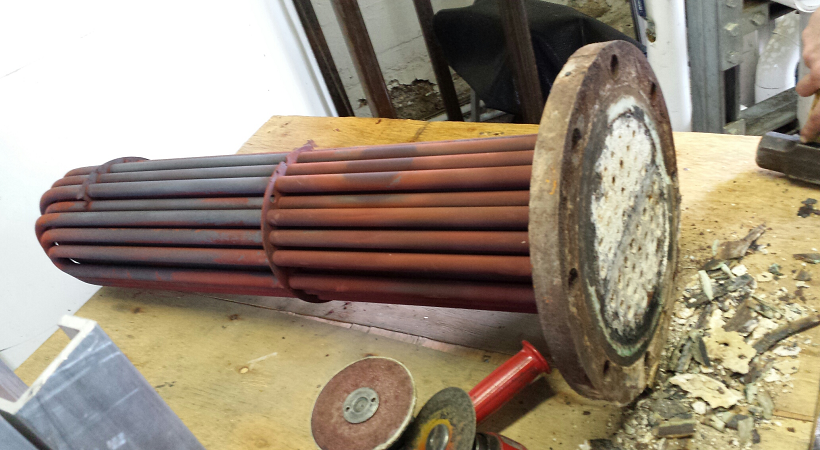
shell and tube heat exchangers and replacement tube bundles for existing equipment. Most of our applications are water to water type or steam to water type of heat exchange. Tube materials are normally copper, carbon steel, admiralty brass, 90/10 cupro-nickel, 304L or 316L stainless steel. Tube sheets can be made of the same materials. We can cross reference many of the big names in our industry to include American Standard, Armstrong, B&G, Old Dominion, Patterson Kelley, Taco, Thrush and many more.
Most domestic water to water or steam to water heat exchangers are constructed of steel tube sheets with copper tubes. Most tubes are rolled into the tube sheet to assure proper tube seating. Then copper or steel intermediate tube sheets are used based on length of bundle to make sure that tubes remain straight and are supported along the entire length of the bundle. Most tube sheets tie into the shell with a “between the bolt” type arrangement with gaskets on head and shell sides of tube sheet.
Why do these tube bundles fail prematurely? It is normally one or a combination of three reasons. There is adverse temperature, adverse pressure or corrosion present. Many of the same reasons why HVAC heating coils fail. It is normally an application whereby the originally selected materials will not stand up to the duty and service or the system characteristics have changed over a long period of time thus causing premature failures.
Any tube material has a maximum operating temperature and pressure rating. The problem sometimes is the original equipment was selected at or very near the maximum rating. Remember that maximum ratings are based on manufacturers one year warranty and have nothing to do with longevity. By selecting a cheaper shell and tube with a bundle that is marginal for the application you will have problems within a short period of time. Since a quality selection should last twenty years or more, when we make a poor selection we now start seeing problems in three or four years.
Corrosion is one of the big problems with bundles inside shell and tube heat exchangers. Many times, either the water (or glycol if present) or steam has been treated and there has been a build-up of corrosive agents that will now attack the tube and tube sheet materials. We have seen many tube bundles replaced in seven to ten years and then have the new bundle need replacing sometimes in a year or two. The owner didn’t realize that the system has changed and there is now corrosive agent present that will destroy a new bundle constructed of the same materials. If the original bundle did not have leak problems for years and then all of a sudden had numerous leaks over a 1 to 3 year period of time, then this is a recipe for a corrosive agent present in a volume that wasn’t there before. Corrosive agents such as nitrates, chlorine, oxygen, carbon dioxide and ammonia are a few that will show up in chemical analysis. Understand that the typical PH tests that everyone receives from treatment companies will not show these corrosive agents. You need to order a special analysis looking for these specific corrosive agents.
There is also another cause of tube bundle failures and it is called “stress corrosion cracking”. This is a combination of stress where the tube and tube material meet with the presence of a corrosive agent. Neither the stress or the volume of the corrosive agent by itself would cause the problem but it is the combination of both being present that causes the premature failure. The leaks look like cracks, usually on the side of the tube about one quarter of an inch from the joint but not actually in the joint.
If a tube bundles needs to be replaced then a specialist like USA Coil & Air should review the problems and then request a chemical analysis to find out what has caused the problem. Then and only then does the owner have a choice to make. Either the corrosive agent is removed or the new tube bundles must be constructed of materials that are corrosion resistant to the present corrosive agents
